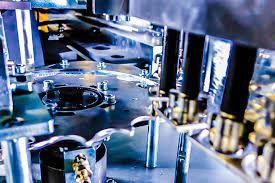
Blow Molding – Commonly Occurring Problems And Their Solutions
Blow Molding – Commonly Occurring Problems And Their Solutions

The blow molding process is a very high-tech manufacturing process that aids the manufacturing of hollow parts in a variety of materials. The process involves melting raw material and then pouring this molten liquid into the blow molding machine. The machine then inflates the liquid by blowing air into it to give it the shape of the mold. In the end, we get a final full-fledged product that requires no further processing mostly and is ready to be used for its purpose. However, it’s easier said than done; it requires immense expertise and practice to carry out this process smoothly. Although most of the work is done by the machines yet the role of the person carrying out the process is very crucial to the successful manufacturing of the hollow parts. Therefore, it will favor that person to be aware of all the problems that commonly occur in blow molding and their solutions. For making it more convenient, we have discussed some of the common problems in blow molding below.
•Bottle Blow-Outs
Bottle blow-outs are very common in blow molding; this problem usually occurs when the mold is contaminated. The presence of moisture also leads to bottle blow-outs in blow molding. If the mold is damaged or the mold closing is too fast, even then, bottle blow-outs happen. If there is bridging in the extruder feed section or the filling speed is too low, it causes bottle blow-outs. Sometimes if the pitch off is too hot or too sharp, even so, the bottle bows out.
Solutions:
To prevent bottle blow-outs from happening again, one will have to check for contamination and moisture in the regrind and resin before starting the process to clean it if it is there and then start the process. In case of damaged mold, one will have to repair the edges of the mold and pinch-offs to avoid the formation of holes in the product. To dodge bridging in the extruder feed section, one should increase the temperature of the rear barrel zone. Similarly, increase the filling pressure, reduce the mold closing speed and increase the width of the pinch-off, and you will not face any bottle out problem anymore.
•Neck Finish
Neck finish has also been a very commonly occurring problem in the blow molding processes. The bottles that have improper neck finish are not good to be used; instead, they are either discarded or melted again to go through the same process again. The reasons that are involved with this problem are having incorrect bottle weight, the alignment of the blow pin is not right or perhaps damaged, the shear steels and pinch-off lands are damaged or if the mold itself is not aligned.
Solutions:
Usually, underweight or overweight bottles lead to inappropriate shearing and issues with neck finish; therefore, the weight of the bottle should also be according to the standard. If the blow pin is not aligned then, one must align it centrally at the right elevation or replace it if it is damaged. In case of damaged shear steels, pinch-off lands, and misaligned molds, one will have to replace the shear steels, pinch-off lands, mold pins, and bushings. These are all the possible solutions that will care for the neck finish issues.
•Bubbles
Having bubbles in your bottles is a major defect, and it happens very commonly in blow molding. The possible reasons could be the presence of moisture in the resin, bridging in the extruder feed throat, very low filling pressure, and worn-out screws or barrel. All these complications cause bubble formations in the bottles.
Solutions:
To prevent bubbling in the bottles, one will have to check for the presence of moisture in the resin; it usually happens as a result of condensation in the feed throat; in that case, reduce the cooling in the feed throat to stop the condensation. The moisture could also if the resin handling system is not tight. However, if you see bridging in the extruder feed throat, then increase the temperature of the rear barrel zone. In case of low filling pressure, you just have to increase the filling pressure. Also, replace all the worn-out screws and barrels beforehand.
Conclusion
However, there are a number of other problems that occur in blow molding, like die lines, indented parting lines, webbed handles, etc., but among them all, we have discussed the most common of them all. Once you have understood these problems and the causes that lead to these problems, your performance will improve twofold. It is crucial to solving these problems at the right time; otherwise, they will do irrecoverable damage to your products and machines. Therefore, be careful and attentive to your blow molding machines all the time and check them regularly.
